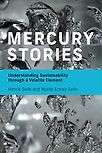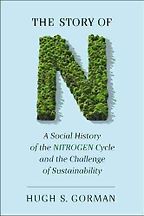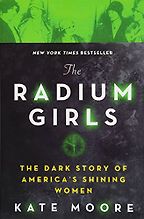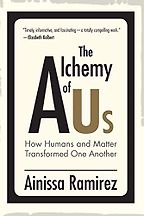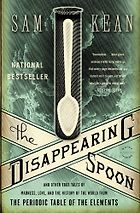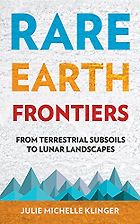Before we get to the books you’re recommending about various elements, do you think the periodic table is a useful prism for looking at the world?
Noelle Eckley Selin: The periodic table contains the building blocks for so many substances that are useful for our society. It’s a language by which materials and technologies are built. I view the periodic table and the elements as the combinations that affect our lives.
Henrik Selin: I agree. One theme in both our book Mercury Stories and all the five books that we’ve chosen is how people have discovered elements and how that has shaped society, but also how society has then shaped these elements, including the way biogeochemical cycles have been altered by human activities. By understanding the elements and how they are connected to each other and to human beings, we get a better understanding of the world around us.
Noelle: There’s also a longtime fascination with the elements, of thinking about what makes up the world, what the components of things are—like earth, air, fire and water, for example. There’s also a fascination with gold and turning things into gold. That’s such a long-time theme in both scientific and popular history.
And, I have to say, the element you’ve chosen to specialize in, mercury, is particularly fascinating and very much part of popular culture. You’ve been working on it for more than 15 years now—how did the fascination with mercury in particular start for both of you?
Henrik: My original research was on hazardous chemicals. I started with legacy chemicals such as DDT, with Rachel Carson raising early warnings in the 1960s, and PCBs, and researched how societies set about discovering the problem with these chemicals and how they regulated—or did not regulate—their production and use. From there, I segued into studying heavy metals, including mercury. I came more from the side of international politics around hazardous chemicals and then moved into focusing on mercury, as it become more of an international political issue in the 2000s.
Noelle: I also started in the toxic chemicals world, but my background is more in the natural sciences. I was looking at how these substances travel through the atmosphere, what chemical reactions they undergo, how they reach faraway places. The idea that toxic pollutants have long been emitted and then have impacts far away has motivated a lot of international policymaking on these substances.
“Nearly everyone has a mercury story”
At the time I was starting my PhD, mercury was of increasing interest in international policymaking circles. I have a very interdisciplinary background; my undergraduate degree was in environmental science and public policy and my focus has always been on the interactions between science and policy. My scientific work is motivated by informing policy and actions to promote sustainability. So, with an increasing interest in mercury from an international perspective—what eventually became the Minamata Convention—I started modeling the transport of mercury in the atmosphere.
Until I read your book, I hadn’t realized the extent to which what happened in Japan was so key to alerting the rest of the world to the dangers of mercury and dealing with it. You really bring out how it was these personal stories that drove the whole thing forward, ultimately resulting in the Minamata Convention.
Henrik: That was one of the conscious decisions that we made, writing Mercury Stories—we wanted to do it in the form of storytelling. We start with the storytellers in Minamata, who drew attention to the pollution disaster that was discovered there in the 1950s but, politically and legally, lasted for many more decades. Some of the other books, not least The Alchemy of Us, are also written in the form of storytelling. I think that’s a compelling way to describe human relationships with elements, both the good sides and the bad sides, because one of the things that we see in all the books is that the relationship between humans and elements is very, very complex. There are some elements that are highly toxic and dangerous to human wellbeing, but human uses of elements can also greatly advance wellbeing. That dichotomy is something that we were trying to get at in our book, and I think it’s highlighted in the other five books as well.
Get the weekly Five Books newsletter
Noelle: That’s one of the things that surprised me most in doing the research on mercury for the book. I had thought a lot about mercury from a scientific perspective and as a policy problem, and I knew that the length of time that mercury cycles in the environment can be very long. But uncovering these stories from generations ago, even centuries and millennia ago, of human interactions with mercury—how people related to the substance and how prevalent and interesting those stories were in popular culture and society, was something I didn’t expect. One of the things we found is that nearly everyone has a mercury story. It has been fun to hear these stories, and many of the stories we heard in our research actually made it into the book.
Although it’s part of popular culture, I was also surprised by how badly informed I was about mercury. Okay, during pregnancy, you get told not to eat too much tuna fish, so I know about that. But a few months ago, I was pasteurizing some apple juice and the thermometer broke in one of the bottles. I had to rush off to check the regulations to figure out whether there was mercury in my apple juice now or not. I found your book very useful from that point of view, just getting a bit up to date on which country has done what to regulate mercury.
Noelle: It’s really surprising the variety of different products that mercury has been in. A lot of people think about thermometers, thermostats, and barometers. But mercury was also in paints. It can be a preservative in cosmetics, in some forms. It’s been in pharmaceutical products and pesticides. There have been a great variety of uses of this substance in its very many different forms.
Is there any other element that is equally interesting, in your view?
Henrik: There are a couple of other elements that are similarly interesting both from an environmental science and policy perspective. Lead is one, and also copper and cadmium, for example. But part of the reason we wanted to write about mercury is that it has a very long history of human uses, going back thousands of years, in its various forms. It is one of the first elements that humans discovered and started making products of and used. In terms of sustainability and materials use, it offers an almost unique, long-term case study.
Yes, including the first Chinese Emperor, Qin Shi Huang, of terracotta soldier fame, who took mercury to achieve immortality. You mention him in your book and, also, I remember reading a news article saying the earth around his tomb was full of mercury.
Henrik: That’s another fascinating thing that comes out in some of the other books as well: there have been a lot of misconceptions. If you ingest a lot of mercury, that is probably not going to extend your life. In fact, it’s probably going to shorten it. But, also, doctors and scientists have known about the toxic qualities of some mercury elements for a very long time. And yet, decade after decade, century after century, mercury use just continued. We also see that in other cases such as with radium, for instance, as highlighted in Radium Girls. There was a decades-long period between scientists discovering that radium could kill you and more comprehensive precautionary measures being introduced.
Didn’t you say, in your book, that mercury is still being used in some cosmetics?
It is, but there is a strong push to phase it out. One of the main remaining major uses is in skin lightening creams, especially in Asia and Africa. It’s not major cosmetics companies producing it, but it’s more homemade.
Let’s go through the books you’re recommending on the chemical elements of the periodic table. First on your list is The Disappearing Spoon, which you mentioned in your email is a great introduction to the subject, good for someone like me who knows very little about chemistry.
Noelle: One of the things I really liked about this book is it uses a map metaphor for the periodic table and how you understand its structure, how different elements are connected, but also with a focus on how they’re connected to society. Money, politics, history, poison, crimes—all of those themes come up.
Henrik: Of the books we picked, this is the oldest one, it came out in 2010. It is a great introduction to the history of the periodic table. The author, Sam Kean, uses a fair number of terms like atoms and molecules and protons and electrons, so if you have some prior understanding of basic chemistry, it makes it a little bit easier to read the book, but I would say even if you don’t have that background, but you are interested in these kinds of issues, it’s a very readable book. There are two other books that we picked that are a little bit more on the academic side, but The Disappearing Spoon is intentionally written as a general audience book, and I think it does a good job of achieving that goal.
Noelle: One of the things the book does is humanize the process of science. It highlights the personalities of the scientists who discovered some of these elements and did some of the fundamental research, and how social connections among scientists resulted in some of the early discoveries and scientific advances related to the periodic table.
Do you have a favourite story in the book?
Henrik: One of the things that Sam Kean does early in the book is that he calls the periodic table “one of the great intellectual achievements of humankind”. I think he’s right. A lot of people may not think about it, but how scientists figured out that periodic table, where the elements are listed, and how they are connected to each other, is essential to the lives that we live today. We would not have the kind of products that we have if researchers had not figured out these relationships.
But if I were to highlight one specific story, it’s about several of the new elements. He mentions a small place in Sweden, Ytterby, which he refers to as “the Galapagos Islands of the periodic table”. It’s this very, very small place in Sweden where they have discovered more elements than in any other place in the world or by any other person. Now, as a small caveat, I am Swedish, so there’s some national pride involved in this. But it’s still a fascinating story. It also directly connects The Disappearing Spoon with Julie Klinger’s book on rare earth metals, Rare Earth Frontiers.
Before we get to that one, let’s talk about The Story of N by Hugh Gorman, which is about nitrogen. Tell me about this book, and why it’s a good one to read about this periodic table element.
Noelle: The Story of N is written by a historian at Michigan Tech, who works in environmental history. It tells the story of societies developing through the lens of nitrogen. It starts in prehistoric times and brings you all the way up to the present, covering the history of agriculture and the creation of agricultural societies, the industrialization of agriculture, the processes that created fertilizer, but also some air pollution issues that come into play with nitrogen chemistry and the emerging environmental problems that come from the human alterations of the nitrogen cycle. Gorman looks at that process and talks about how societies have addressed ecological limits with technologies and policies.
“The relationship between humans and elements is very, very complex”
Henrik: Given that it’s written by a historian, it’s a chronological story, that goes through the nitrogen cycle before humans and then after humans became a major force on planet Earth. It documents the very major changes that humans have made to the nitrogen cycle, especially over the last 200 years. One of the things that I really like about this book is that it does this in the context of sustainability. That’s one of the connections between The Story of N and our book, Mercury Stories, that it’s very much written in the context of understanding and advancing sustainability. It’s not just The Story of N for the sake of The Story of N, but about what it means for advancing human wellbeing and sustainability now and in the future. So if one is interested in the elements, in environmental history, and relationships between elements and societal development and sustainability, then I think that this is a really good book.
Noelle: One of the things that struck me about it was that it’s so different from a scientist approaching the nitrogen cycle. As a scientist, you learn about global cycling and the technological processes that alter the global cycle. One of the things that Gorman stresses in this book is that a lot of this is explained by institutions, by markets and by the progress of science. That’s a very different lens than just looking at the technological or scientific developments in isolation.
Can you give an example from the book to help visualize what it’s about?
Noelle: As a scientist who models the transport of substances, and when I think about ecological transport, I think about mobilizing material from the oceans to the atmosphere, for example. But one of the examples that Gorman gives is that nitrogen was also moved in large quantities by trade, by human actions. A large-scale import of guano from Peru was moving from South America to Europe for production of nitrogen-based fertilizer. That was a major source of the nitrogen fueling increases in agricultural production. And it was a resource that was present and then was exploited and moved—before the development of technologies for fixing nitrogen in fertilizer.
Let’s go on to Radium Girls now, which is by Kate Moore. Tell me why you’ve included this one.
Henrik: This is another book that is written for a general audience. Kate Moore is an English author who discovered this story when she directed a play called These Shining Lives by Melanie Marnich. That play focuses on the Ottawa, Illinois case that is described in the book. Radium Girls is about the problems that afflicted girls who worked in factories in two places in the United States—Newark and Orange, New Jersey, and Ottawa, Illinois—where they were painting watch dials using radium.
Noelle: They did very technical painting with radium, which glowed, so was important for seeing in the dark—also for instrument dials in wartime. The painters, all women, would shape the brushes using their lips; it was called lip painting. That exposed the painters to radium, which was the material in the paint. Radium was used in medicines, and there was a thought among the people who worked there that it was good for you. But then they started experiencing severe poisoning.
It’s a story that is echoed in a lot of pollution narratives of industrial workers being harmed by substances, and then the denial and legal battles and economic interests that pushed against the realization and action to mitigate those harms. It’s a very familiar type of story, unfortunately, which you see echoed in a lot of different cases where people were harmed and their experiences weren’t recognized by regulators, by policymakers, by the legal system. It oftentimes took decades before these issues were fully appreciated and the victims were compensated. We see this with mercury in the Minamata case as well, in Japan.
But in the end, the radium girls did get recognition and get compensated?
Noelle: The second half of the book talks a lot about their legal battles and their struggles with the legal system, not only to get compensation but also to prevent this kind of thing from happening again.
Henrik: Also, many of the girls died before they could get any compensation. The authorities were slow to act. Corporate managements, in both cases, were denying any kind of responsibility, dragging it out, appealing. They were basically trying to run down the clock, thinking that if they could keep this going in the courts and the workers died before there is any kind of legal settlement, then they would be off the hook.
Noelle: The book also looks at public awareness of environmental hazards—the role of journalists and the role of people telling stories to promote greater understanding of environmental harms and in particular harms to workers in the context of industrial production.
Let’s talk about Rare Earth Frontiers by Julie Klinger, which you’ve already mentioned. Before we start, you’d better tell me what rare earth metals are.
Henrik: The thing about rare earth metals is that they are neither rare nor earth. Here we are, back at that very small place in Sweden, Ytterby, because when the first of these metals was discovered, it was just assumed, since no one had discovered it before, it had to be rare. We now know that it’s actually fairly abundant, but this moniker of ‘rare’ has stuck.
Currently, there are 17 chemically similar elements that are in this rare earth category. The first one was discovered in Ytterby in the late 1700s. This was 230 plus years ago, which is very different from mercury that has been known about and used for millennia. And even if some of these rare earth metals were used before, they have only entered the arena of big business over the last couple of decades, because of the technological revolution with computers and cell phones and satellites and batteries for electric cars. This is where the rare earth metals have become economically valuable and integral to modern society.
Noelle: One of the things that Klinger says in the book is that their applications “mirror the best and worst of the world we’re building.” You have all of these technological applications, renewable energies, for example. But also uses in explosives and weapons and other kinds of military applications.
What’s a common application? Can I have an example of a rare earth metal and what it’s used for?
Noelle: A good example is neodymium. It’s used in a lot of the consumer electronics technologies. So hard drives and also renewable energies, like wind turbines, solar panels, but also in missiles and drones. It’s used a lot in magnets. There’s a great table in the book of what the rare earths are and what they’re used for.
Henrik: One of the things I like very much in this book is that it’s based on extensive field research. Klinger looks at one established site for mining rare earth metals, one explored site where the large-scale production has not yet started, and one prospective site. The established site is in Inner Mongolia, part of China. She traveled and did research there. The explored site is in the Brazilian Amazon. She also traveled there and looked at potential mining on indigenous lands in the Amazon.
“Ytterby…is a very, very small place in Sweden where they have discovered more elements than in any other place in the world”
Her prospective site is on the Moon and clearly she did not travel there. But she frames her book in the context of a frontier: what is a frontier? As a human geographer, Klinger thinks of frontiers in a temporal sense—frontiers are moved over time—as well as in a spatial sense as frontiers are moved into “new” places, but she also looks at cultural, political, and scientific dimensions of frontiers. She talks about how this notion of frontiers in mining for rare earth metals is very intimately tied into issues of imperialism and colonialism and oppression and nationalism. It’s a really interesting book for people who are not just interested in the rare earth metals, but also resource extraction more broadly. Who benefits from resource extraction? Who is harmed by resource extraction? Who has power? Who doesn’t have power?
So unlike mercury and lead these metals aren’t toxic? When we talk about sustainability, we’re talking more about the process of extraction and what that does to the environment, rather than that these elements are inherently dangerous?
Noelle: They can be toxic, particularly at high levels. It depends on the substance, there are a lot of different ones. They’re not used in high quantities in products, but certainly the environmental impact in these mining areas and digging up a lot of elements can be toxic. One of the truisms in toxicology is the dose makes the poison. That comes from the work of Paracelsus, who worked with mercury. How much you’re exposed also determines the impact. In a lot of these cases, though, the highest exposures in these areas are to well-known dangerous substances that are co-occurring with some of these rare earth metals.
Henrik: Right, because in places where these rare earth deposits are high enough in concentration that they’re actually mineable, it often coincides with other hazardous elements—like uranium and thorium, arsenic and fluoride and other heavy metals. So, as you extract these rare earth metals, you’re unearthing a lot of these other toxic substances too. Then that mining waste is often just tossed to the side. Local communities and local people can suffer from severe poisoning not from the rare earth metal necessarily, but all the other hazardous substances that are dug up at the same time.
There’s the example in your book of the 16th century silver mines in Mexico, where they were extracting silver which is OK, but they were using mercury to do it.
Noelle: Right. And I think that’s where rare earth mining has a lot of parallels with mercury. One of the really important challenges in mercury and sustainability today is that it’s still used in artisanal and small-scale gold mining. Industrial mining has moved on and uses different technologies to mine gold, but artisanal and small-scale gold miners still use mercury. Klinger talks a lot about the differentiation between artisanal mining and industrial mining in these different frontier areas, how it’s looked at in society and done by different groups, how it’s regulated.
One of the challenges with artisanal mining is it’s often an important part of livelihoods in regions where people don’t have a lot of other options. This is something international efforts to control mercury have been dealing with, to try to figure out what to do about sustainable livelihoods in places which are heavily dominated by mining. In her fieldwork, Klinger goes to communities which are involved in rare earth mining and engages different actors—in particular, in the case of Brazil, how indigenous peoples and miners are interacting in some of these frontier regions.
Let’s go on to the last book, which is The Alchemy of Us by Ainissa Ramirez.
Noelle: This was one of my favorite books of the last year, about materials and how materials were shaped by inventors, but also how those materials shaped culture and society. One of the neat things about the book is that each of the eight chapters is titled by a verb—interact, connect, convey, etc. It’s focusing on materials, several of which are elements, but also combinations of elements. Ramirez pays attention to people who aren’t always that well known, surfacing the hidden stories of these discoveries.
Henrik: The Alchemy of Us is another book that is largely written for a general audience. Since we are talking about elements, one way to look at this book is that it brings out the human element in all of this. As Noelle said, these materials were shaped by inventors, but those materials shaped culture and society. Many of these inventions have had very positive effects on human societies and human well-being—in terms of communication, in terms of light, in terms of being able to travel and so forth. But, towards the end of the book, she also talks about negative effects.
Five Books interviews are expensive to produce. If you're enjoying this interview, please support us by donating a small amount.
For example, the last chapter is focused on the development of the silicon chip, with silicon being an element. The internet and Google and social media have changed the way we receive information and interact with other people. And this is, in fact, rewiring our brains. This is something that we should be aware of and think about. What kind of society do we want going forward? How do we want to interact with each other, and might there be some downside to this idea that we should continuously be connected or hooked up to something?
Noelle: She stresses how technological development can both reinforce existing power dynamics and biases but also change them. She gives the example of color film exposure being optimized for taking pictures of white people versus Black people. This reinforced existing biases, and she talks about how that changed but also how that’s reflected, even today, in facial recognition software.
The book opens up the idea that there are ways of developing technology and thinking about who is involved to potentially mitigate some of these biases.
That’s one of the things that we think about a lot, in areas of sustainable development: how to empower different groups in society. And I think this is also a theme across the books. Who is making decisions? Who is harmed? Who is benefiting from these substances? That’s something we draw attention to in the mercury case in particular. You brought up the silver mining example. Silver production was benefiting colonial rulers, but at the same time killing the indigenous peoples who were the miners. Reckoning with that history is, I think, a theme in almost all of these books, as well as in Mercury Stories.
Interview by Sophie Roell, Editor
June 9, 2021. Updated: June 11, 2021
Five Books aims to keep its book recommendations and interviews up to date. If you are the interviewee and would like to update your choice of books (or even just what you say about them) please email us at [email protected]

